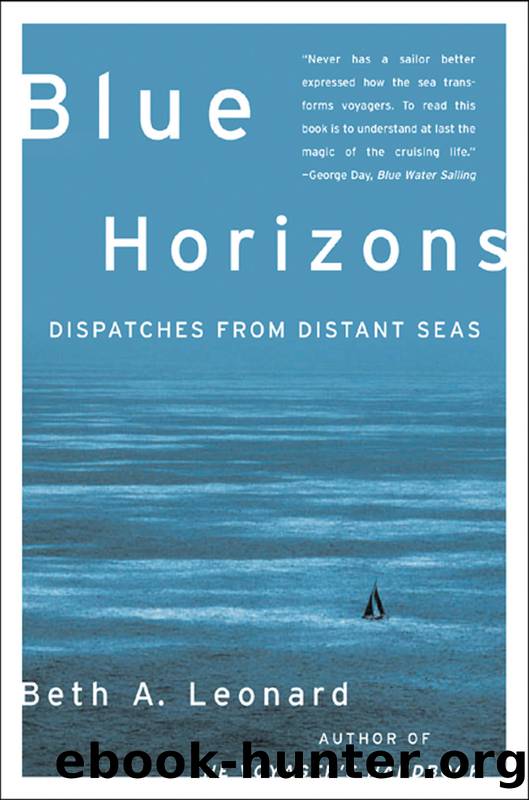Blue Horizons by Beth A. Leonard

Author:Beth A. Leonard
Language: eng
Format: epub
Publisher: McGraw-Hill Education
Published: 2007-05-15T00:00:00+00:00
* * *
44° 28ⲠS, 73° 38ⲠW
Isla Filomena
Canal Moraleda, Chile
March 18, 2002
EVANS licks the last of the chocolate cake batter from the serving spoon and puts the spoon back into the bowl. âWhen was the last time we lazed on deck in T-shirts?â he asks.
I drop down next to where he is sitting on the coach roof, lie back, and close my eyes, luxuriating in the feel of the warm sun kissing my face and caressing my bare arms. My mind searches back over 3,000 miles and five months, to northern Argentina and our final days in the tropics, before I come up with a memory of voluntarily spending time above decks in anything less than three layers of clothes. âMar del Plata,â I murmur. I roll over and look at him. âI can hardly believe that less than two hundred miles south of here you were wearing your survival suit while we sailed through the brash ice fronting a glacier face.â
Since crossing the Golfo de Penas at 47° S three days ago, we have entered a whole different world. Golfo de Penas, or Gulf of Pain, represents a major milestone for those cruising Chileâs archipelagoâthe only place where yachts must leave the shelter of the channels to brave the Roaring Forties on a dangerous and shoal lee shore. But it also represents a major transition in climate and geography.
When we sailed out Canal Messier and entered the Golfo de Penas, we left behind the tortured, bonsai-like trees clinging to the bases of rain-scoured, wind-ravaged mountains and the katabatic winds blasting across anchorages and raising mini-waterspouts. We entered Bahia Anna Pink, just north of 46° S, to find lower, rounder islands, their silhouettes softened by forests of tall, straight beech and conifers that afford real protection from stronger winds. In the last few days, we have sailed past the occasional field or grassy area and working and abandoned fishing campsâa surprise after the many months spent in a raw, brutal, virtually uninhabited land. The barometer rocketed above 1012 millibars for the first time in several months, and sunshine and warm weather have replaced the torrential rain two days out of three and the gale- to storm-force winds once or twice a week that we grew used to farther south. The wind, which blew anywhere from 30 degrees apparent forward for all but two days out of two months south of the Golfo de Penas, shifted aft when we came into Bahia Anna Pink. Instead of motor sailing, we have been able to sail every one of the last three days. Itâs as if, in a 120-mile overnight passage, we left the Chilean channels far behind and were somehow transported to the gentle landscapes and temperate weather of southern Ireland or Nova Scotia.
âYou know what I like?â Evans asks as he stretches out on the deck beside me. âJust dropping an anchor and not taking an hour and a half to put shore lines out. I never appreciated how simple and easy that was before this.
Download
This site does not store any files on its server. We only index and link to content provided by other sites. Please contact the content providers to delete copyright contents if any and email us, we'll remove relevant links or contents immediately.
The River by Peter Heller(2213)
Breath by James Nestor;(2202)
Deep by James Nestor(2116)
Fatal Storm by Rob Mundle(2114)
Sea Survival Handbook by Keith Colwell(2088)
Lonely Planet Australia by Lonely Planet(2010)
Iced In by Chris Turney(1913)
Discover Australia by Lonely Planet(1878)
Lonely Planet Maldives (Travel Guide) by Planet Lonely & Masters Tom(1773)
Looking for a Ship by John McPhee(1611)
One Girl One Dream by Dekker Laura(1600)
Ten Degrees of Reckoning: The True Story of a Family's Love and the Will to Survive by Hester Rumberg(1581)
Chicken Soup for the Ocean Lover's Soul by Jack Canfield(1580)
Lonely Planet Australia (Travel Guide) by Lonely Planet & Lonely Planet(1534)
South with the Sun by Lynne Cox(1495)
The Wave In Pursuit of the Rogues, Freaks and Giants of the Ocean(1455)
Diver Down by Michael Ange(1450)
Marlinspike Sailor's Arts and Crafts by Barbara Merry(1432)
The Golden Rules: 10 Steps to World-Class Excellence in Your Life and Work by Bob Bowman & Charles Butler(1409)
